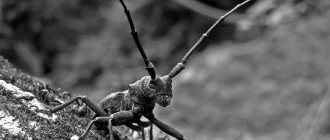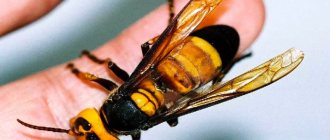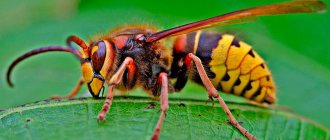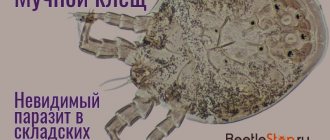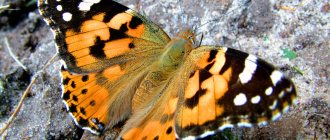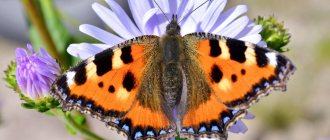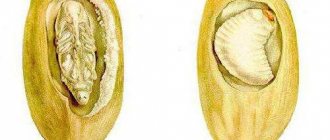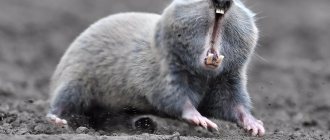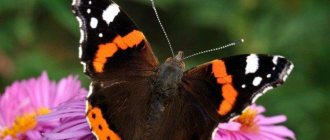The water mite is an inhabitant of freshwater and marine waters. What types of aquatic parasite are common in our country. What do these small parasites look like and where do they live? Do they pose a danger to humans? Effective control against infestation of aquariums and decorative ponds.
When we hear about ticks, we often imagine blood-sucking individuals that live in forests and parks. But ticks live not only in grass and bushes; in addition to land dwellers, there are also individuals from the aquatic environment.
Next, we will take a closer look and find out who the water mite is, whether it poses a danger to people and how to recognize such individuals.
Species and habitat
Water mites, like blood-sucking parasites, are classified as arachnids. There are a huge number of types of them. They are divided into 2 families of hydracarynes, which include 4000 species. Regarding our country, more than 500 species of these families live on its territory. In turn, hydracarynes are divided into freshwater (Hydrachnidae) and marine (Halacaridae).
Hydrachnidae
Representatives of the first group, as the name suggests, are inhabitants of fresh waters; they are found in rivers, ponds, and reservoirs. These individuals belong to the group of predators, so their largest populations are found in places where there is enough food, which is small invertebrates.
They do not depend on external conditions, and water temperature is not a vital factor for them. They tolerate low temperatures well and can be seen in icy water.
Regarding appearance, they can be recognized by their rather bright body color. Most often, these representatives have bright shades from yellow to bright red.
The most common species of the freshwater family include:
- Hydrachna geographica. One of the largest representatives of the family. Adults can reach sizes of 8mm. Spring and early summer are the period of their maximum activity; during this period they reproduce. A huge number of them can easily be seen on the surface of the water of reservoirs, ponds and even puddles. The individual has well-developed legs, thanks to which it swims. They are bright red with black dots.
- Hydrochoreutes ungulatus. These representatives have a small body and fairly long legs. The color of the body is yellowish with dark spots. They most often live in ponds and large bodies of water overgrown with mud.
- Hydrachna cruenta. Individuals parasitize other inhabitants of the aquatic environment, for example, scorpions and swimming beetles. Their sizes are quite large, adult individuals grow up to 6-7 mm. The body is flattened with widely spaced limbs, which makes movements seem uncertain. You can see what ticks look like in the photo.
Halacaridae
The most common marine representatives are Atax ypsilophorus. The size of the body is quite large; the adult parasite grows to 8-9 mm. They have long, well-developed limbs with which they can move quickly. This species is also called Unionicola.
They hunt and feed on bivalves, so they are most often found in the coastal zone. Their bodies have a bluish tint, so in the right lighting it is almost impossible to notice them in the water.
Individuals of this species are excellent hunters. When they notice a prey, they attack and grab it with their long legs. There are small notches on the legs that prevent the mollusk from freeing itself. It is these representatives who resemble their fellow spiders in behavior.
Features of physiology
Ticks have a rather bright appearance, which is easy to notice in the water surface. One might assume that they are easy prey for other species, but this is not entirely true. Arthropods are rarely found in the stomachs of fish, and scientists have repeatedly noticed that if a fish grabs a tick, it spits it out almost immediately. This is due to the ability of arthropods to secrete poisonous or unpleasant-tasting liquid from their glands. Therefore, small creatures rarely become prey to large aquatic predators. The bright color acts as a warning.
They swim well in water; it is enough to place one individual in a jar of liquid and you can observe chaotic and rapid movements. Some representatives only crawl on aquatic plants, and therefore lead an exclusively bottom-dwelling lifestyle. Ticks are predators and feed on zooplankton and invertebrates. The basis of nutrition is daphnia, cyclops and other small animals. The tick grabs the victim with its jaws and sticks to it.
Mature females lay eggs on stones and underwater plants. Most often, the clutch is laid in a heap, rather than attaching one egg at a time. The clusters are colored yellow or bright red, so they are easily visible on the surface. The larvae choose water striders, swimming beetles, water scorpions, and, less commonly, dragonflies and dipterans as hosts.
A water bug is often mistaken for a tick. He has a similar lifestyle, as he spends most of his time in a pond. But he is not even a relative. The bug is larger, it has three pairs of legs. It does not pose any threat to humans, but you should not grab it with your hands, as the insect can bite strongly. In rare cases, this leads to allergic reactions. Lives only in freshwater. Most often it spends time on the surface of the water; if desired, it dives into the depths, but this takes serious effort.
Body structure
Depending on the species, they may have some differences in the shape of the body, most often it is round in shape. The body consists of the abdomen and cephalothorax; they are located very close, so it seems that they are fused together. They have 4 pairs of legs, each with claws that are designed to hold the victim and hairs that help move in the water.
The number of eyes also depends on the species, some have 4, and some only 2. According to scientists, the eyes are protected by capsules, which allow individuals to see perfectly even in turbid waters.
Trixacarosis
This disease, caused by mites, appears only in guinea pigs. Infection of animals with subcutaneous microscopic mites occurs through direct contact with sick individuals.
Diagnostics
A distinctive feature of this disease is the long absence of any symptoms. The female, who gets on the skin of a guinea pig, penetrates its thickness and lays eggs in it. After some time, the animal begins to feel discomfort, severe itching and severe pain, up to the appearance of convulsions.
The animal begins to scratch itself. Alopecia appears at the site of scratching. In pregnant females, infestation with such a mite can cause abortion.
Treatment
Demodicosis (subcutaneous mite). Causes and treatment
Diseases of guinea pigs. Treatment of guinea pigs.
Guinea pigs. Bathing for fleas... or “vibrating mouse”
Life cycle
On average, water mites live for about a year. Reproduction begins in the spring; in winter they are least active. In winter, most ticks are in the nymphal stage. Under favorable conditions, they reproduce very quickly. If there is a large accumulation of hydrocarines in a reservoir, the water may take on a red tint.
Each species has its own reproductive characteristics. Some species, due to the fact that the males have a much smaller body than the female, resort to cunning and stick to the abdomen of the female to mate. Some can search for a female for a long time; at the same time, they lower their paws into a special pocket where the seminal fluid is stored, and when they find it, they independently transfer it to the female.
Next, eggs are laid; the location of the clutches depends on the living conditions. If it is stagnant water, then clutches of eggs are left on the roots of plants, stones, and snags. If it is flowing water, the offspring are attached to the stems of plants. Marine inhabitants lay eggs on coastal stones that are submerged in water.
Larvae emerge from clutches of eggs. At this stage, the mites have an elongated body and legs, but there are only 6 of them. If it is a small body of water, the larvae can cover the entire surface of the water. For further development, the larvae must find a victim. Once found, they attach securely to their body, parasitize, and pupate to transition to the next nymphal stage.
At the nymph stage, the parasites have the size of the body of an adult tick. Further, in the nymph stage, having chosen the next victim, the second stage of pupation occurs, after which the stages of development are completed and a sexually mature individual appears.
Nutrition
Water mites are also parasites, most of them are predators. The basis of the diet are:
- plankton;
- aquatic invertebrates;
- small crustaceans;
- seaweed.
Aquatic parasites often attack mussels and can remain on one individual for almost their entire life or periodically change their host. Such a “tenant” will not cause death, but it will take away the vitality of the chosen victim.
On a note!
The water mite is not at all dangerous to humans; the arthropod will not even think of attacking such a large warm-blooded individual.
Water bug
There is another aquatic inhabitant that is very similar to ticks. Unlike ticks, these bugs can attack people and cause quite painful bites.
These representatives have large body sizes, they can reach 15 mm. They are quite dangerous and aggressive predators towards all inhabitants of the reservoir. Adults attack fry and even their own young relatives.
They have wings that are strong enough and can cover distances. At night, they quite often leave bodies of water, flying towards the light, which attracts them very much.
These parasites cause very painful bites. Most often, after a bite, the wound becomes red and very itchy. Bite areas should not be scratched, as this can cause infection and only make the situation worse. Antihistamines, for example, you can use Fenistil, will help get rid of itching and relieve swelling. You can also use hormonal agents, for example, Hydrocortisone. Places where a concentration of these parasites has been observed should be avoided. In nature, especially near bodies of water, it is better to use protective sprays.
Red heifers
A very small type of parasite. Adults are about 1 mm in size, larvae are 0.02 mm in size. Larvae parasitizing mice cause thrombidiasis in humans. Signs of thrombidiasis:
- itchy, inflamed spots;
- nodules;
- pustules.
The signs are very similar to flea bites.
When bitten, larvae can transmit some infectious diseases:
- Q fever;
- tsutsugamushi;
- African tick-borne rickettsiosis.
Red heifers
Thrombidiasis is caused by the larvae themselves. Their food is not blood, as for ixodids, but skin cells. The larvae of red mite mites live under the skin, in the hair follicles. The body reacts to the introduction of the larvae by the formation of irritated spots and itching. Scratching can cause a complication - pyoderma. The latter is caused by pyogenic cocci. After feeding for several days, the larvae fall away from the host and the remaining stages of transformation take place on the ground.
The appearance of water mites in the aquarium
Infection of aquariums can occur from soil or food that contains parasite eggs. They pose a great danger to crustaceans. Cyclops and daphnia are the most attacked. Regarding living conditions such as an aquarium, better conditions simply cannot be found.
Fish do not even consider parasites as food; there are situations when a fish accidentally swallowed an individual, but immediately threw it back. The only thing that can force a fish to consider ticks as food is a severe lack of nutrition.
It is quite easy to notice an infestation in an aquarium; thanks to the bright color of the body, they become immediately noticeable. Getting rid of them is not so difficult; in case of severe infestation, a complete cleaning of the aquarium will be required.
You need to do the following:
- We take any container, fill it with dechlorinated water and move all the inhabitants of the aquarium into it.
- When relocating, be sure to inspect everyone’s body for the presence of attached parasites.
- It is necessary to get rid of the soil, completely get rid of everything, even if there are no adult parasites in it, most likely there are already eggs there, so if you leave it, there will be new infections.
- Next, take soap and a sponge and thoroughly wash the aquarium, paying attention to the corners. Afterwards, wash thoroughly with water to avoid any soap residue.
- All decorative elements require processing; if possible, they must be boiled for 5 minutes, if not, then also use soap and a sponge.
- Place new soil. It must be purchased at a pet store, as it can be specially processed.
The sponge that was used for washing must be thrown away. An estimate of water, soil and treatment of elements will quickly get rid of the problem. But if an ornamental pond is infected, then completely different actions are required. Regarding ultraviolet sterilizers, they are not effective in this case.
Pest Control Methods
Pest Control Methods
If you find a parasitic spider on a vegetable or flower crop, you can use folk remedies to get rid of spider mites. Some of the most popular methods include:
- The simplest method is spraying with ice water. This option is suitable for saving roses.
- Treatment with an infusion of onion peels helps well against spider mites. You need to pour one liter of water into a handful of husks, cover tightly with a lid and wait 6-7 hours. The resulting liquid is sprayed onto the affected leaves.
- Garlic infusion is a universal remedy against garden mites. His recipe is simple: 150-200 grams of finely chopped garlic are infused in one liter of water in a closed container for 5 days. The resulting concentrate in an amount of 6-10 grams is diluted in a liter of water. The working solution is used to spray foliage.
- The soap solution is suitable for treating indoor flowers and vegetables. To do this, 50 grams of laundry soap are grated and dissolved in a liter of water. The soapy medicine is sprayed onto the plant.
- Alcohol can be a good way to protect your plant from flower mites. You need to put a few drops of alcohol on a cotton swab and wipe each leaf of the flower with it. Excessive use of alcohol can cause burns to tender leaves.
- To destroy spider mites, you can purchase its natural enemy, the predatory mite phytosailus. It multiplies quickly and will help get rid of parasites at all stages of development in a short time. And when the food runs out, the predator will die.
Insecticides to combat spider mites
When an infestation with a spider pest has turned into a large-scale disease, you need to move on to radical methods. Chemical insecticidal and acaricidal preparations can save the plant even when it is almost completely susceptible to this scourge. Among them, the most popular are:
- Karbofos is an organophosphorus product based on the active ingredient malathion. It has a detrimental effect on parasites and causes paralysis and poisoning upon contact with them. The tops of garden crops should be processed in calm, dry weather early in the morning. The protective effect lasts for 7-10 days.
- Apollo is an effective acaricide, the action of which is aimed at poisoning the eggs and larvae of ticks. When an adult comes into direct contact with a chemical, it ceases to be able to reproduce.
- Fitoverm is a biological insecticide. It can be used for indoor flowers without fear of chemical poisoning. The ampoule with the drug is diluted in water and sprayed on the foliage. The protective effect lasts up to three weeks.
- Plant-Pin sticks are a new way to protect flora from the effects of ticks. The sticks are impregnated with the active substance butoxycarboxim. They are stuck into the pot along the perimeter of the plant stem. The number of sticks depends on the diameter of the pot. The larger it is, the greater the number of sticks you need to stick into the pot. When watering, water dissolves the insecticide and saturates the roots with it. The plant becomes invulnerable to parasites within 2 months.
Antiklesch and Kleschevit are also effective.
Pond infestation
To combat parasites in small enclosed reservoirs, chlorophos is used.
It belongs to insectoacaricidal agents, when using which the following rules must be observed:
- Treatment can only be carried out if the air temperature is below 25°C.
- Apply from the leeward side.
- Preparation of the solution and processing is carried out only outdoors; it is allowed to be carried out indoors, but only on condition that it is well ventilated.
- During the procedure, gloves, a respirator, and safety glasses are used.
- People who have diseases of the hematopoietic organs and cardiovascular system are prohibited from working with the drug.
The drug has a detrimental effect not only on ticks, it destroys zooplankton, which is the food of parasites.
Lifestyle
The activity of meadow ticks begins earlier than that of dog ticks. It is the dermacentors that can attack at a time when thawed patches have just appeared on the ground. Their peak activity occurs in April-May. A second, smaller peak of activity in this species is observed in the fall.
The life cycle of the meadow tick from egg to death lasts 1-2 years. The development of an arthropod from egg to unfertilized adult should take 1 growing season. Adult ticks overwinter.
Eggs are laid only in spring. The cycles of transformation from larvae to nymphs and then to adult meadow ticks are short. Peak activity of these forms occurs in July and August.
The young parasitize small mammals. Definitive hosts of parasites:
- sheep;
- goats;
- horses;
- cows;
- dogs;
- wild boars;
- deer;
- foxes;
- jackals.
Meadow tick
An adult meadow tick can be dangerous to humans due to the feeding habits of its young forms.
Meadow ticks mate on the host. Before this, the female must drink blood for 8 days. Having sucked, she needs to have time to mate within 3 days. After this, she falls to the ground and lays 3-5 thousand eggs.
Although the meadow tick prefers damp places, it can successfully compete with the pasture tick in drier biotopes due to the ability of the larvae to wait out hot and dry times by burrowing into the soil. In fact, grass mites replace each other during the warm season. Meadow grass larvae “go” into the moist layers of the soil from May to August. At this time, the young animals of the pasture lead an active lifestyle.
Correct use of the drug
To carry out the treatment, it is necessary to prepare a working solution. To do this, take a container and pour chlorophos powder and fill it with water in a ratio of 1:7. The water temperature should be 18-20°C. Next, you need to thoroughly stir the solution.
To apply, pour the working solution into smaller containers that are convenient to work with. It must be applied in such a way that the coastal zone is captured. 5-7 days are enough to purify the water.
Although they do not pose a danger to humans, they cause great harm to aquatic organisms that are part of the zooplankton.
They can with full confidence be classified as dangerous enemies of those who maintain decorative ponds and aquariums. Source
Danger to humans
In the summer, many people prefer to swim in different bodies of water. Observant individuals can spot bright red dots on the water. In fact, water mites do not pose any danger to humans. They don’t stick, bite or crawl into different cavities, so you don’t have to be afraid of them.
There is a common misconception that ticks lay eggs on the human body. This does not apply to water creatures. They are also not interested in people as a food item, since their jaws are adapted only for zooplankton and invertebrates.
The main threat comes from terrestrial tick species. Argasidae prefer to settle on animals and birds. They are quite large and can reach a length of 30 mm. They can be found in nests, cracks, and burrows. One bite of an argas tick can infect a person with typhus; the puncture site will itch and hurt for several weeks.
Scabies mites are difficult to detect with the naked eye. It is transmitted from human contact with another person. As a rule, a fertilized female passes, which, when a new host appears, lays eggs under the skin. The larvae are actively hatching and spreading. After which the person exhibits the first symptoms of scabies.
Forest ticks pose a great danger, as they can be carriers of encephalitis and Lyme disease. They quietly attach themselves, and the virus enters the human blood. Therefore, if an arthropod is detected, you should immediately contact the nearest hospital, where they will take the tick for analysis and, if necessary, give an injection of immunoglobulin.
Source
How to avoid falling into the clutches of a parasite? How to protect yourself and your family from bites? Children's protective equipment
Considering that there is still a risk of contracting dangerous infections, although not so high, it is recommended to avoid contact with such parasites if possible. To do this, use available and special tools:
- essential oils - have a repellent property and are able to deter parasites for a short time, but it has been experimentally established that the duration of action of such substances is short (a few minutes, and often less);
- repellents, acaricides and combined preparations (repelling, killing ticks), they are applied to the skin or clothing;
- special suits - made for women, men, children, can protect a person for a long period, as they completely cover the body, have a smooth surface, there are also traps, there are cuffs on the sleeves, as well as a mosquito net, there is additional protection at the bottom of the jacket ( designed to be tucked into trousers).
For children, special products are used that are characterized by a milder effect, for example, Gardex, Moskitol-Antiklesch.
Protective suits for adults and children
Disease carriers
The dog tick, like any other species of ixodid, is capable of transmitting a large number of diseases. Some pathogens are safe for humans, but can cause death in domestic animals:
- Luping's disease;
- pasture fever.
Other diseases in humans and animals are common:
- borreliosis;
- tick-borne encephalitis;
- Q fever;
- Staphylococcus aureus.
Tick-Transmitted Diseases
If ticks bit people as often as animals, we would all get Staphylococcus aureus. 30% of humanity are carriers of this disease. Only ticks infected with tick-borne encephalitis and borreliosis are of medical importance in Russia. Both diseases are dangerous and relatively widespread in the Russian Federation.
Egg
Under a microscope, mite eggs resemble fish eggs. This is a large cell, covered with a soft membrane and containing the yolk, cytoplasm and nucleus. The outer shell can be smooth or ribbed. The eggs have different colors and two shells: the outer one is dense, and the inner yolk is thin. The shape of the egg can be:
- round;
- flattened;
- elongated;
- oval.
Each type of tick has its own specific egg shape.
The size of the egg relative to the body length of the mature female is very large. Typically the egg is larger than the last abdominal segment. After the eggs mature, the female lays them in a secluded, damp place.
Reproduction of ticks
Because of this, some species of ticks have developed a very original method of viviparity: postmortem. With this method, after the eggs ripen by autumn, the female does not lay eggs, but dies. The eggs remain overwintering in the female's body. In the spring, the larvae hatch and eat their way out into the wild. One of the reasons why ticks die is procreation. The uniqueness of this method of reproduction, according to experts, arose from the fact that the eggs are too large to be laid without the death of the female.
Interesting!
In two species: bread mites and pot-bellied mites, true viviparity is observed.
Demodicosis
Young individuals are often affected through direct contact with an infected mother.
Diagnostics
Finding and seeing this microscopic insect is almost impossible without a special device. But its presence can be determined by certain signs:
- the skin of the head and extremities is covered with papules and pustules, which after some time transform into ulcers;
- the affected areas become bald;
- Swelling of the limbs is possible, so a sick pig may limp.
Treatment
Diagnosis is carried out by taking a scraping and examining it under a microscope.
Treatment of the disease is carried out with drugs that include the substance Ivermectin. It is worth considering that this is a toxic drug, which means it can only be prescribed by the attending physician.
In addition, the sick animal is bathed in chamomile decoction using Doctor shampoo. This procedure does not help cure a sick animal, but it eliminates unpleasant symptoms during the main treatment period.
Lifestyle
Life cycle of a tick
The European part of Russia is relatively free from encephalitis, while in Siberia outbreaks of the disease have been observed since early spring, when there are no other blood-sucking parasites.
There are claims that an adult lives only 3-4 months, but the appearance of the disease in early spring is due to the fact that already at a temperature of 1°C encephalitis ticks wake up after wintering and go in search of prey.
In fact, the life cycle of an encephalitis tick can be from 2 to 4 years. The lifespan of an arthropod depends on environmental conditions. The minimum development cycle takes 2 years; in the northern regions, the development time from egg to adult can be 4 years. The average development period is 3 years. With a three-year period, the development of each stage of the encephalitis tick takes 1 year. In winter, arthropods enter diapause.
At all stages of development, encephalitis ticks overwinter in the forest litter, cracks in stones, and in the surface layer of soil. Both hungry and blood-drinking individuals leave for the winter.
The preimaginal stage takes 2-20 weeks. Its duration depends on environmental conditions. Maximum activity of sexually mature encephalitis ticks occurs in May-June. The larvae emerge from the eggs in mid-summer.
Parasites need blood not only for their own development, but also for oviposition. Therefore, males feed little on blood, sometimes doing without it altogether. Females drink a lot. The female, sucking without interference, impresses with its large size.
Where to expect an attack?
Ticks need feeders to survive. Therefore, they are located exactly where many people and animals pass. They climb to the very top of bushes or blades of grass and wait for their prey. When walking along forest roads or through coastal thickets, you should not touch or touch low-hanging branches, bushes and tall grass with your hands. Do not sit on a litter of leaves or branches.
Ticks have no eyes. Thanks to their excellent sense of smell, they sense the approach of humans and warm-blooded animals from 10 meters away. In anticipation of their approach, the parasite extends its forelimbs to latch on.
It is on the front legs of the tick that the olfactory organs are located. Moving them from side to side, the tick understands from which side the victim is approaching and tries to grab onto it. Thanks to special hooks and suction cups at the end of the legs, the tick firmly clings to everything it touches.
Most often, the parasite sneaks under a person’s trouser leg and moves higher, attaching itself to the leg or groin area or leg. A person does not feel the bite because, together with its saliva, the tick injects a substance with an analgesic effect into the bite site. Then it plunges its proboscis under the victim's skin and begins to suck blood. The special “cementing” properties of saliva firmly fix it in this position. Once satisfied, the tick disappears. A well-fed tick increases in size up to a centimeter.
Among the total number of ixodid ticks, about 5% of individuals are carriers of dangerous diseases. They can cause the following serious diseases:
- tick-borne encephalitis is a life-threatening disease;
- borreliosis is a bacterial disease that, in the absence of timely treatment, leads to irreversible changes in the brain and death;
- piroplasmosis is a disease of domestic animals transmitted through tick bites;
- hemorrhagic fever.
